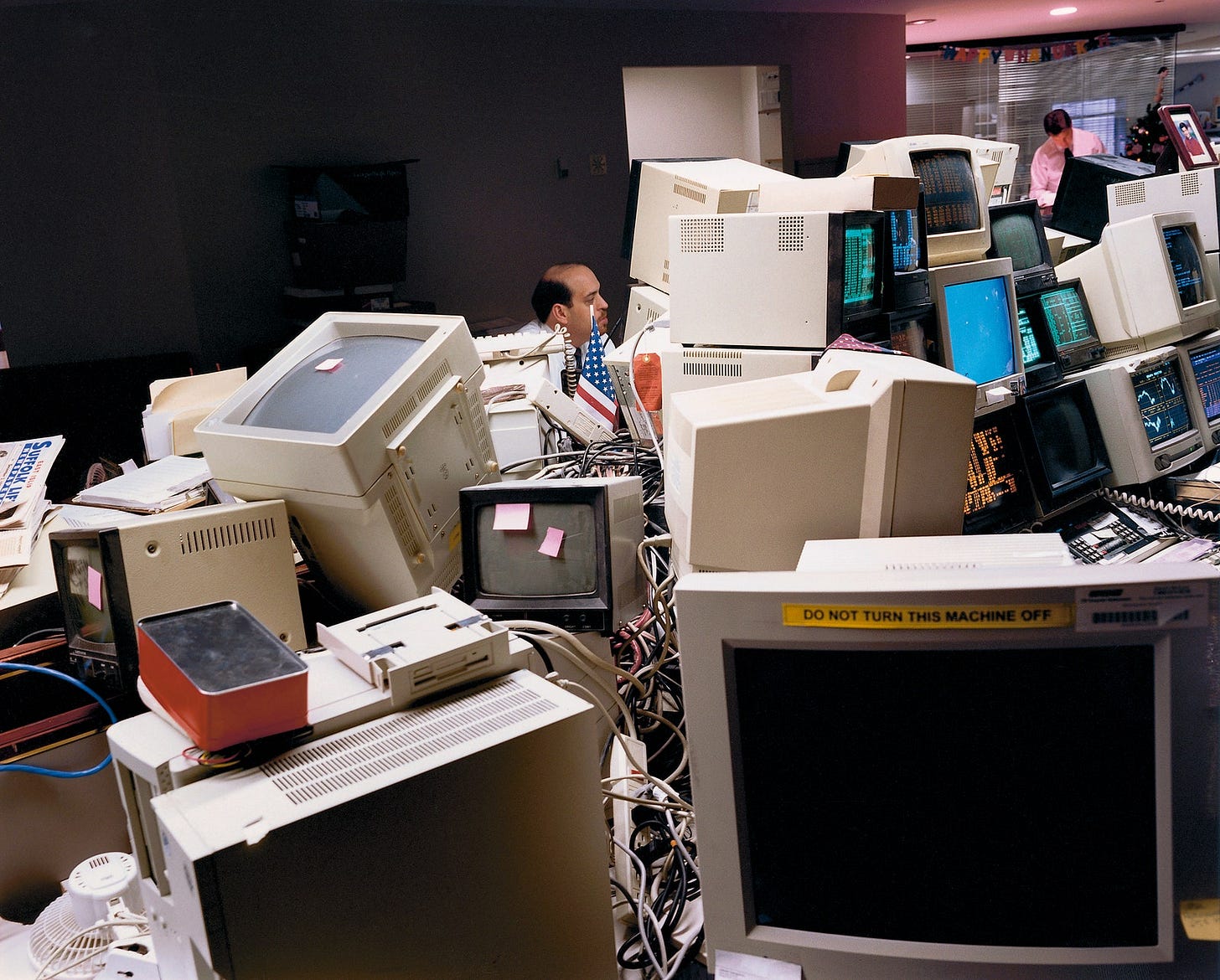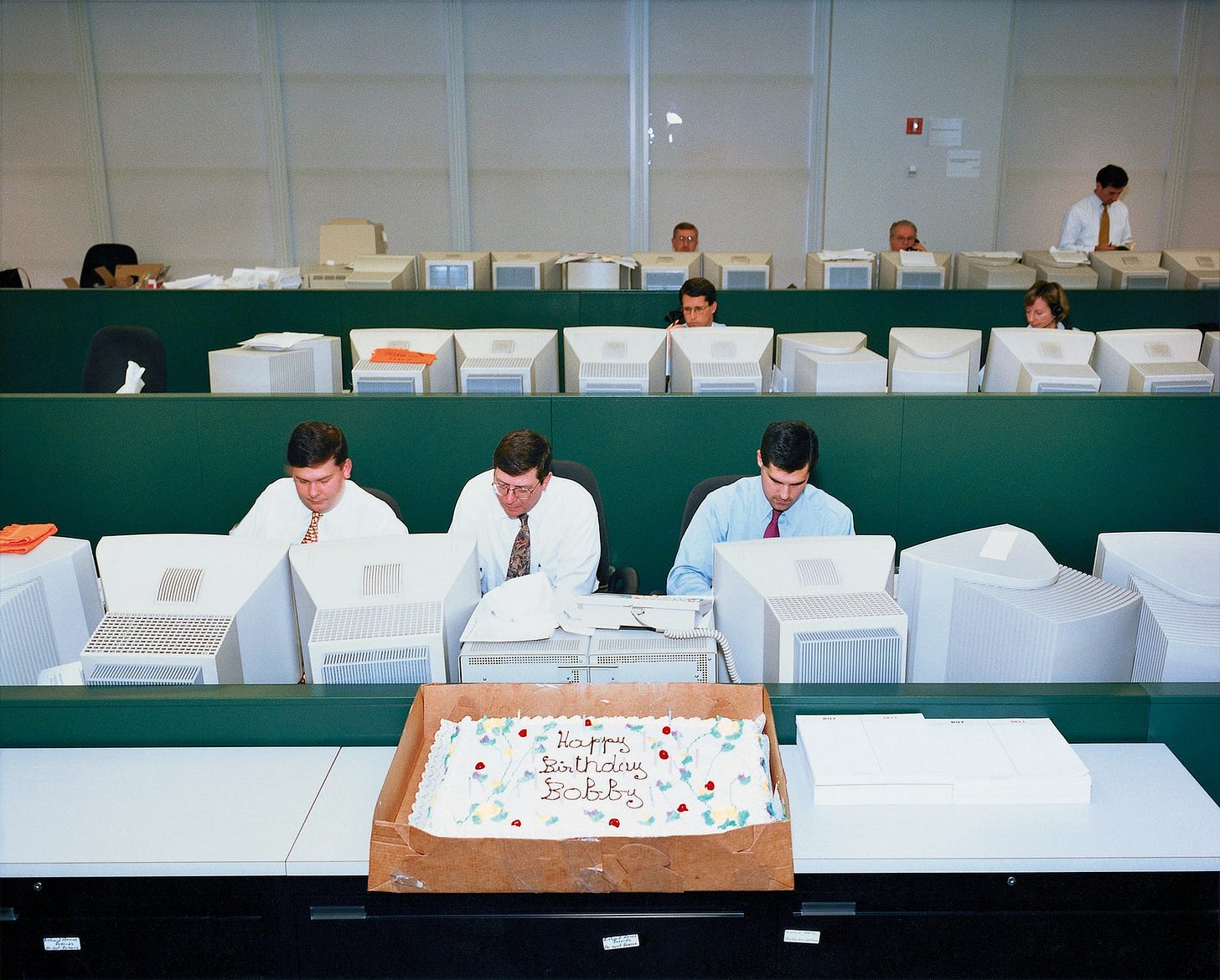What does a "Good Workspace" look like anyway?
Your environment plays an outsized role when it comes to how you work. We're shifting time away from the office, but what's going to replace it?
A few weeks ago, Cal Newport put out an article for the New Yorker titled “The Frightening Familiarity of Late-Nineties Office Photos.” We live for photo collections like this. Shot by the late, great Lars Tunbjörk, the series of images documents corporate life, leading up to and just before the dot com bubble burst. Soulless, banal, depressing - it’s the cliche that is corporate life, even sadder than you could imagine.
This period, as told through these photos, marks a shift in how offices were used. What were previously physical spaces used for the collaboration and efficiency-through-proximity become housing centers for infrastructure that lets the people be anywhere. It’s a strange time, the messy middle where the technology exists, but it’s pretty rudimentary still, and we haven’t quite figured out what to do with it yet. I think what’s especially interesting during this period is that we hadn’t actually left the buildings yet, or moved IT into it’s own closet at least. Nor had anyone thought that maybe we should hide some of the cords, apparently. What resulted was man and machine, working simultaneously under one - probably carpeted, definitely fluorescent lit, beige wall painted, likely still asbestos in the ceiling tiles - roof. Not pretty, not fun - though by most economic measures unbelievably productive decade. All that productivity, and some creativity on the balance sheets, eventually led to the dot com and housing bubbles - but that’s another story.
Luckily, some things have changed. Some of us have learned that this environment is kind of miserable, and that miserable employees usually burn out, so we hired interior designers. Turns out that a little sunlight, some plants and a pop of color go a long way for boosting morale. Some have also figured out that we probably don’t all need to be in the building together all of the time anymore, and now we can take our computers home with us, so that’s nice. What Cal points out is that despite the clearly dated aesthetic, the images feel all too familiar. Not because of the cords, or the suits, or the coldness of the offices, but because of our relationship to technology. We still feel disconnected and oppressed by the technology at times, and no slick UX or open office plan can change that. So that leaves us with the question: “How can we improve this?"
The State of the Office
The rise of remote work has for a majority of people, I believe, been a net positive change. The benefits flexibility provides are hard to quantify, and any reduction in productivity, which seems to be company to company and not as a whole, seem to be offset by things like turnover and employee satisfaction. Sure, it’s not for everyone. I even prefer working in an office myself, but the idea that it’s the best way for everyone to work all of the time is ridiculous.
It’s been about 30 years since these photos were taken. We’ve got computers in our pockets that are thousands of times faster than a 90’s desktop. We’ve got all the tools to let your coworker James to spend 3 months of the year in Bali and still (barely) get his work done, and most of the cords have disappeared since everything is processed “in the cloud” or, more accurately, a little outside of Dallas. Offices don’t need people anymore, and computers don’t need offices anymore. So what’s the office now, anyway?
All these changes have led to incremental improvements in office design, but the core concept of “office” hasn’t really shifted. Surprisingly, I don’t think it really needs to, because what we need from an office hasn’t really shifted either. From what I’ve seen, it appears the leaders at most companies have come to the conclusion that the office is great for a few things on occasion, but that most work can be done elsewhere. That is, unless, they have office space exposure on their balance sheet that is so heavy they can’t justify not filling it, or are unbelievably stubborn and narcissistic. I also actually think that’s fine - if you wan’t your team to be fully in office, good for you, but know you’re sacrificing talent because of it.
For the way an office is used today in a post Covid, post iPhone world, the basic needs of a good workspace are simple - space to gather, space to be alone, good natural lighting, don’t make it all beige. If you’ve hit these things, you’re basically 90% to an “office of the year” award. What we think is interesting at Offsite is not what the office will look like in the future, but what fills the void that is left when you’re a distributed team?
Offsite: A Supplemental Solution
We don’t need to burn down the offices. It might be nice to convert some of them to housing, because we do need more of that, but we can still keep some offices. Like pretty much every thing in life, absolutes are not helpful. The office isn’t dead, remote work isn’t the only way forward - the future will hold a spectrum, and that’s a good thing. With that expansion of the spectrum, Offsite is designed to become a third-space. Like all things, the real estate of the workplace is trending towards specificity and optionality. Whether it’s one of our cabins in your backyard to get you out of the house once in a while or a team retreat to connect and bond, we’re building the obvious choice.
We’ll dive deep into our designs in later essays, but it starts with location. Nature is a big player in what we do, and that’s because it’s proven to change the way your brain works. You need to be able to wander, to explore, to clear your head and let inspiration strike. So we build outdoors.
The cabins are minimal, but warm. Every piece is thoughtfully designed and calibrated to reduce friction. Ergonomic workstations, a kitchenette so you can stay in and crank if you need to, hidden whiteboards behind the art, and integrated storage to reduce clutter. There’s a small inspiration library and some fun puzzle sculptures as well, so you can integrate a bit of play into your routine, which is shown to encourage creativity. In the ethos of Dieter Rams, it’s less, but better. It’s thoughtful hospitality for a very specific purpose.
We’re betting on a flexible future, and in that future we believe that most companies, whether your a solo graphic designer or Walmart (who recently made all remote positions return to office some days) will operate under some hybrid model. Given the tax implications of fully remote teams on companies, it likely looks like distributed teams in specific states / countries, with an office in strategic locations. In this future - which is already here for many - there are still a few hard things:
How do we gather as a team a few times a year to bond, collaborate, and strategize?
How do I get this proposal done in time while working from home with my kids in the house while school’s out for summer and the house is being remodeled?
I’ve got the flexibility to work wherever next week, where’s the obvious place to go?
These are the problems we’re out to solve. They’re basic, but represent a pretty significant shift in the way that we structure our time around work. We also think they’re important ones - problems that can significantly improve quality of life, and combat the feeling that Tunbjörk so vividly captures in his images.
It’s a trope - the cabin in the woods that serves as the backdrop for strokes of genius. But it’s a trope for good reason. If you’re interested in giving it a try and finding out why, give us a shout.









